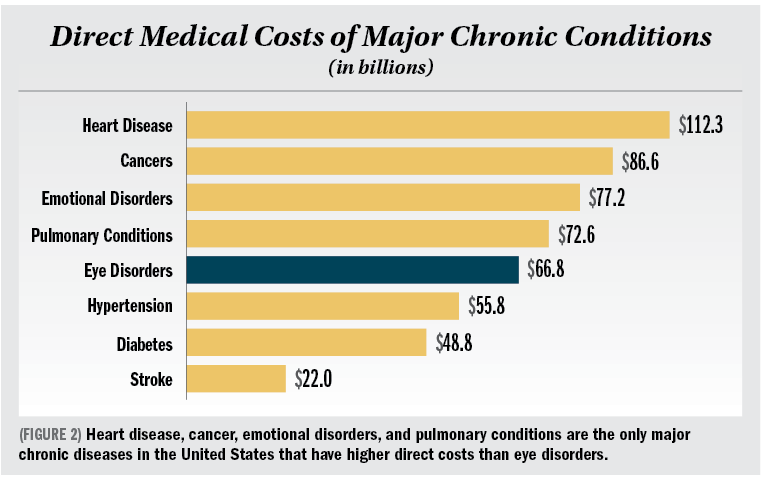Article
Report: Eye disorders cost $139 billion per year
Through improved communication and coordination with patients and other health care professionals as well as advocacy for increased or maintained funding for prevention of vision-related problems, ophthalmologists can help decrease costs associated with eye disorders and vision loss, according to a report commissioned by Prevent Blindness America.
Take-Home:
Through improved communication and coordination with patients and other health care professionals as well as advocacy for increased or maintained funding for prevention of vision-related problems, ophthalmologists can help decrease costs associated with eye disorders and vision loss, according to a report commissioned by Prevent Blindness America.

Direct and indirect costs associated with eye disorders and vision loss total $139 billion per year, according to a research commissioned by Prevent Blindness America (PBA).
The amount, noted in the “Cost of Vision Problems” report, puts eye disorders ahead of hypertension, diabetes, and stroke when it comes to direct costs. Heart disease, cancer, emotional disorders, and pulmonary conditions are the only major chronic diseases in the United States that have higher direct costs.

Todd“I don’t think eye health gets the attention nationally in our public health sector that these other chronic conditions get, largely because those conditions often result in death if nothing is done with them,” said Jeff Todd, JD, MS, chief operating officer of PBA. “But the cost of eye disorders to our society is right up there with these other conditions, and so we need to pay attention to that.”
Direct costs, accounting for 48% of the $139 billion total, include expenses associated with diagnosed disorders and undiagnosed, self-reported vision loss; medical vision aids and vision-assistive devices and adaptations; and services, such as special education, school screening, and assistance programs. Indirect costs include productivity losses, nursing home and informal care, and entitlements and tax deductions.
Annually, patients and their families are paying 52% of the total, primarily for costs associated with productivity losses and informal care. The federal government and private insurers are footing the bill for 32% and 16% of the total, respectively, mostly for direct medical costs and long-term care. (The federal government also pays for entitlement programs and tax deductions attributable to blindness but not included in the report’s total costs.)
What ophthalmologists can do
Ophthalmologists can undertake several actions to help decrease costs associated with vision-related diseases, said Todd as well as John Wittenborn, one of the University of Chicago researchers who conducted the research on behalf of PBA.
• Improve communication and coordination of care with other eye-care professionals (ECPs) and primary-care providers (PCPs).
“We need to encourage increased collaboration across all health-care fields, because people are going to need to have a more comprehensive approach to their health care,” Todd said.
Coordinating care not only could help detect and treat vision problems earlier, lowering costs; it also could assist with patient adherence to therapy recommendations, especially with patients with diabetes, he added.

“Diabetics face many different health conditions that they are having to juggle, and they often are seeing multiple providers. It’s easy for them to lose track of medications or appointments and to lose track of their health altogether,” Todd said. ”So the more we can work together as a health-care system to make it easier for patients to address their health-care needs, the better.”
Telemedicine and other advances, such as electronic health records, should ease information-sharing and care coordination between ECPs and PCPs, Todd said. For instance, PCPs could perform retinal imaging that ophthalmologists could read remotely and then provide guidance, increasing services available to patients.
“We also have some work to do educating PCPs about paying attention to the eye and encouraging their patients to seek follow-up care when needed, and to address those concerns that they can within their own offices,” Todd said.
The sharing of care, as appropriate, among ophthalmologists, optometrists, and PCPs will help ensure that health-care professionals can keep up with the demand for eye-care services, Todd said.
• Educate patients that neglecting vision care now could lead to more costly expenses later.
“The costs of vision problems . . . add up, and it’s worth letting the patients know,” Todd said. “It’s not only about their health; losing your sight is costly.”
“Patients must understand that they will end up paying for the bulk of costs from eye disorders and low vision,” Wittenborn said. “Loss of vision is not only a quality-of-life issue; it is a very substantial financial issue for patients, their families, and the nation. This puts the value of proper eye care and prevention in stark relief.”
• Advocate for increased or maintained funding for prevention of vision-related problems.
The Centers for Disease Control and Prevention’s Vision Health Initiative (VHI) receives annual funding of $481,000, or $0.00000346 for every dollar that vision problems cost American society every year, Todd said.

“Only a few years ago, the VHI was at $3 million annually,” he noted. “Without a sufficiently funded, dedicated federal program to address vision problems, the prevalence and costs of these problems will only increase.”
Todd said that PBA is “encouraging everyone to advocate for increased funding or at least a maintained level of funding” for prevention efforts.
Preventive care will decrease costs, Wittenborn said. The report indicates that eye disorder and vision loss costs disproportionately affect the oldest Americans, he said, and because this group is set to be the fastest-growing segment of the population, these costs are expected to continue to grow.
“If there is any good new in this, it is that most of the costs to society are indirect costs-consequences of low vision, such as productivity losses, informal care, and long-term care placement,” Wittenborn added. “These are costs that can be avoided by preventing vision loss.”
Recent advances, such as molecular therapies for age-related macular degeneration, while seemingly costly in and of themselves, have the potential to avoid even greater costs by preventing or delaying vision loss, he added.
The new research updates a 2007 PBA report, uses revised methodology and cost data across the age spectrum (including children for the first time), and considers all disorders related to the eye. The full report can be accessed at http://costofvision.preventblindness.org.
Subscribe to Ophthalmology Times to receive the latest clinical news and updates for ophthalmologists.
Newsletter
Don’t miss out—get Ophthalmology Times updates on the latest clinical advancements and expert interviews, straight to your inbox.




